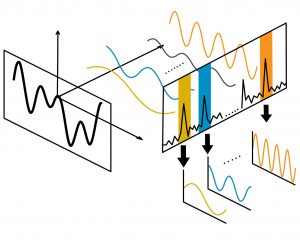RESOURCES
PARALLEL PROCESSING ARTICLE
Parallel processing of 1024 channels in a single receiver
We see a continuously growing number of communication signals in the spectrum. At the same time wireless communication standards are increasingly diverse. Using conventional methods for communication surveillance and spectrum monitoring would increase the cost almost proportionally to the number of signals. New cost-efficient solutions are needed to effectively monitor the diverse communication signals and to identify RF interferers.
By Carsten Watolla, Department Manager Spectral Data Analysis “SDA”
Background
Before it is possible to listen, analyze or further process a communication signal, it first needs to go through a down-conversion chain. The chain includes mixing a real IF-signal, downsampling and filtering it. This process is also called channelization. The mixer converts a digitized real IF-signal to a baseband complex signal. Downsampling the signal reduces the amount of data which makes inline processing much less processing intense. Filtering eliminates all unwanted frequency components from the signal of interest. The mixing, downsampling and filtering are done by digital downconverters (DDC) sometimes referred to as digital drop receivers (DDR). DDCs are traditionally being implemented on application-specific integrated circuits (ASICS) but are today commonly used together with field-programmable gate arrays (FPGA). Dependent on the quality of the implemented filter and the flexibility of the downconversion stage a DDC requires more or fewer hardware resources.
For applications requiring a few wideband signals a common approach is to build individual DDC blocks to get the best performance. Implementing hundreds of DDCs by building individual DDC blocks multiplied by the number of needed DDCs however would become very resource heavy and costly since larger FPGAs or more FPGAs would be required.
Thus, in order to handle hundreds of narrowband signals it is common to use less resource heavy processing techniques which typically introduce some practical limitations for narrowband applications. Frequency domain filtering (FDF) gives the user limited possibilities to tune each channel individually as it is dependent upon the spacing of the FFT bins. A Polyphase FFT Filter Bank (PFFB) implementation is limited to equally spaced channel structures.
Solution
Novator Solutions partnered up with RFEL to provide a cost effective yet flexible multichannel receiver implementation for narrowband communication surveillance and spectrum monitoring applications. It allows parallel processing of up to 1024 channels in a single receiver.
The proprietary channelization solution is comparable with a functional parallel DDC block implementation. It provides full access to configure each channel individually. The per channel configuration parameters include DDC on/off, center frequency with a sub-Hertz (<1Hz) tuning resolution, output sample rate, gain and choice of FIR output filter coefficient set. All configuration parameters can be changed during run-time.

Figure 1 Channelized signals of interest
Trade-offs
There is a trade-off between the input bandwidth versus the number of available channels. Some real-world examples which have been realized with Novator Solutions multichannel receivers and intelligent RF spectrum recorder:
1: HUGIN 200: FPGA target: Kintex-7 410T; Input bandwidth: 4x80MHz; Available channels: 512
2: HUGIN 2000: FPGA target: Kintex-7 410T ; Input bandwidth: 200MHz; Available channels: 1024
3: ODEN 3001: FPGA target: Kintex Ultrascale KU-060; Input bandwidth: 200MHz/765MHz; Available channels: 1024/128
The other theoretical trade-off is the maximum aggregated output sample rate. Each DDC is internally decimated in two steps, first a coarse decimation, and second a fine decimation. Due to the chosen design, the aggregate coarse rate cannot exceed the master clock rate. Thus, the minimum guaranteed aggregated output rate is ½ the master clock rate and maximum the master clock rate. While there is some more complexity to it below are the numbers for earlier mentioned three examples:
1: HUGIN 200: IF sample rate: 100MS/s; Master clock rate 250MHz; Aggregated output rate: 125MHz – 250MHz
2: HUGIN 2000: IF sample rate: 200MS/s; Master clock rate 250MHz; Aggregated output rate: 125MHz – 250MHz
3: ODEN 3001: IF sample rate: 800MS/s; Master clock rate 256 MHz; Aggregated output rate: 128MHz – 256MHz
Conclusion
Narrowband communication signals are typically in the kHz to low MHz range. To detect weak signals good dynamic performance is required why the input bandwidth is often limited to 80 MHz to 200 MHz. We can conclude that both trade-offs have little to no practical impact for narrowband communication.
Thanks to the level of flexibility combined with the unparalleled performance this multichannel receiver implementation can be used in demanding applications such as narrowband COMINT, ITU spectrum management or satellite communication where concurrent monitoring of many communication channels are required.
Finally, the resource efficient implementation ensures a lower cost per channel compared to traditional solutions.

Hugin 200 Multichannel Receiver
Hugin 200 is a small footprint Multichannel Receiver. Enable to extract 256 demodulated/IQ narrowband channels out of four 80 MHz tuners.

Hugin 2000 Multichannel Receiver
Hugin 2000 is an 19” rack mounted Multichannel Receiver. Based on two high end tuners Hugin 2000 extract 2048 demodulated/IQ narrowband channels.

ODEN 3001 - INTELLIGENT RF SPECTRUM RECORDER
ODEN 3001 is the first intelligent RF spectrum recorder within Novator Solutions wideband record and playback offering with 26.5GHz frequency range and 765MHz real-time bandwidth.
CONTACT
Do you have questions about our products or need help with your purchase? Don’t hesitate to contact us by phone, email or by filling in the contact form. We look forward to hearing from you.
